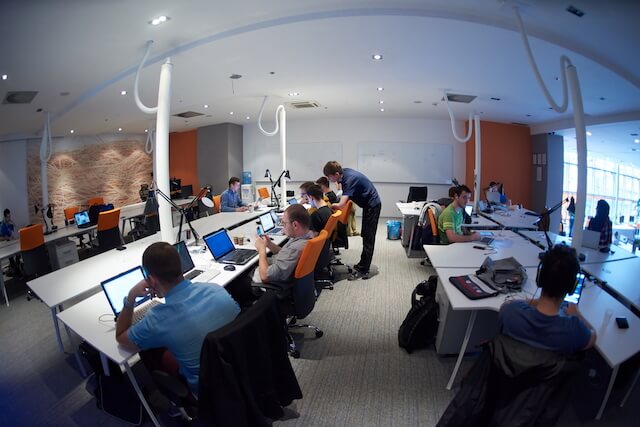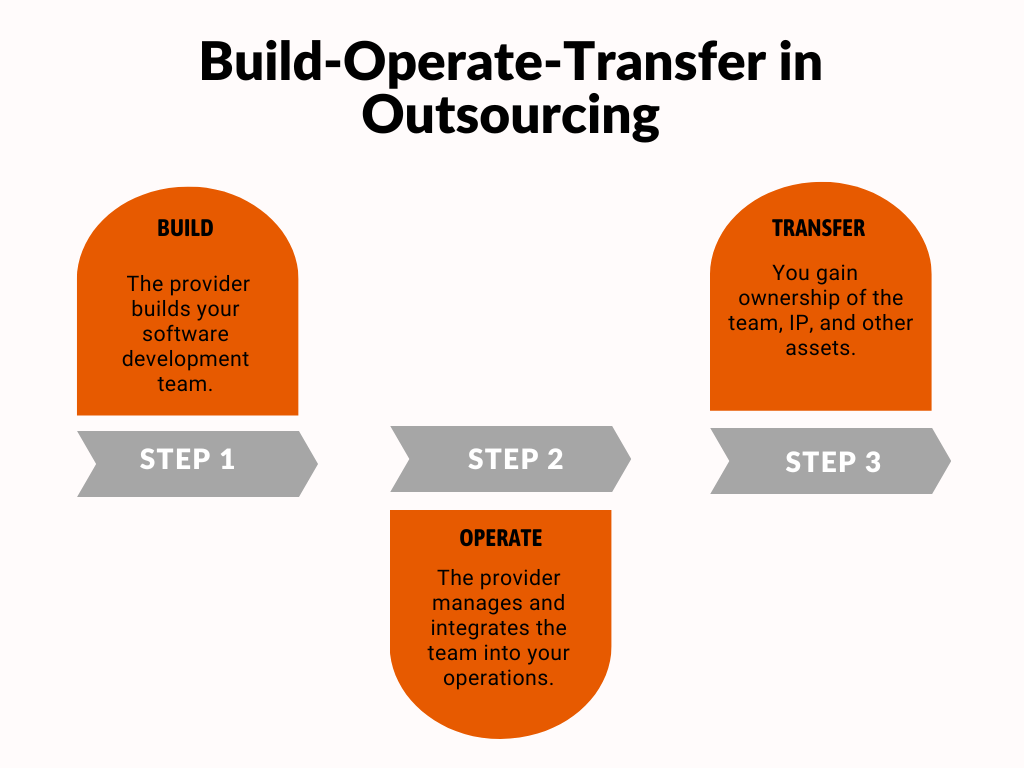
Build Operate Transfer in IT Outsourcing: Benefits and How it Works

IT outsourcing has become a cornerstone in the tech industry. Both startups and multinational enterprises use this approach to optimize budgets, access talent, and speed up time to market. Remarkably, more than 60% of companies outsource at least a portion of their app development activities!
If you’re also among the proponents of outsourcing, there’s a possibility you’d like to take it to the next level by building a sustainable offshoot of your company in an offshore/nearshore zone. This approach is known as Build-Operate-Transfer IT outsourcing, offering some benefits that traditional outsourcing might not fully cover. In the Build-Operate-Transfer paradigm, you can enjoy all the benefits of traditional outsourcing while retaining full control over the development process, technologies, Intellectual Property, and other assets.
Are you intrigued by this approach? Here’s what we’ll highlight in this post:
- Definition of Build-Operate-Transfer outsourcing;
- It’s distinctions from other outsourcing models;
- How Build-Operate-Transfer software development works;
- Benefits that companies get with Build-Operate-Transfer IT outsourcing.
What is Build-Operate-Transfer in outsourcing?
Build-Operate-Transfer (BOT) is a type of engagement, which involves partnering with a provider of R&D centers in a foreign country. The scope of services in Build-Operate-Transfer in outsourcing includes:
- Providing office space and infrastructure;
- Assembling a full-fledged IT team;
- Offering legal and finance assistance;
- Managing payroll;
- HR and recruitment;
- Other functions related to operating a remote tech branch.
The provider’s task is to ensure the branch and the team works like a well-oiled machine, smoothly and efficiently.
A distinguishing aspect of this model is the eventual transfer of the remote office to the client. That includes the team, technologies, accumulated expertise, and IP. The date of transfer is typically specified in the contract.
BOT assumes collaborating with a partner in a nearshore or offshore destination for a pre-defined duration, commonly around 3 years. Throughout this period, the partner is responsible for building your software development team and managing ongoing operations. After that time is up, your company gets 100% of the fully operational team, technologies, and acquired know-how.
Build-Operate-Transfer model vs. Outsourcing: The difference
If it sounds familiar, you’re correct. The Build-Operate-Transfer model has a lot in common with traditional outsourcing. In both approaches, the provider builds a team of software developers based on the client’s needs, goals, budget, and other parameters. However, the main distinction is the ownership of the team:
- Outsourcing: The team remains under the ownership of the provider throughout the project’s duration;
- Build-Operate-Transfer: In contrast, this approach revolves around the eventual transfer of the team to the client’s organization.
In essence, BOT combines the best of both worlds – creating your remote tech unit and partnering with a vendor to handle it.
Both models let you forge strategic partnerships that contribute to accelerating software development processes, optimizing your budget, accessing talent, and more. Outsourcing lets you hand off any operation, including minor tasks. However, in the context of Build-Operate-Transfer, you can enjoy a larger scope of services, related to building a fully-equipped remote tech unit catered to your needs.
READ ALSO: IT Offshore Outsourcing: Pros and Cons
Build-Operate-Transfer software development: How does it work?
Build-Operate-Transfer is exactly what it says on the tin. It entails 3 distinct functions: Build, Operate, and Transfer. Now, let’s examine each one individually.
Build
In this phase, the provider creates a foundation of Build-Operate-Transfer outsourcing – a team of software developers with the underlying infrastructure. Using their internal resources, they set off team formation, onboard team members, rent an office space in your chosen tech hub, and provide the necessary IT infrastructure.
Operate
After the team is assembled, a wide range of management duties come into play. It includes overseeing the team’s work and supporting employees as well as taking care of the office. Thus, the provider takes care of all day-to-day functioning of the team and monitors software development tasks. Most importantly, they integrate the offshore/nearshore team into your internal operations. Besides that, the partner provides team management services, focusing on the employees’ well-being and comfort, HR support, and fostering their career growth. The primary focus for the provider is enhancing the team’s retention. Before the next stage kicks off, the team’s efficiency should be at its best.
Transfer
Finally, the pivotal moment for both parties in Build-Operate-Transfer outsourcing arrives: Preparing for the complete ownership of the unit by your company. At the date specified in the contract, the provider launches the transfer process of the team and all operations to your organization. The provider also facilitates the registration process for your company’s foreign subsidiary. At the same time, a comprehensive transfer takes place, including team members, knowledge transfer, IP, and other assets. The outcome of this stage is a fully functional branch completely integrated with your organization, operating without any middlemen.

READ ALSO: Your Guide to Project Transition Plan from one Vendor to Another
Why opt for Build-Operate-Transfer outsourcing?
Why do CTOs go for Build-Operate-Transfer outsourcing? To address this question, we’ve listed a few key benefits of this approach below.
Access to a wide range of skills
Among the biggest beneficiaries of the Build-Operate-Transfer model are businesses located in the US and EU regions, which often have to struggle to source talent for their projects. This challenge arises due to the high demand for skilled software engineers. The BOT model is a viable solution, as it provides access to approximately 2 million software developers with solid skills in a variety of technologies located across Eastern Europe and Latin America.
A seamless extension of your company
Unlike an outsourcing model, Build-Operate-Transfer software development refers to directly hiring team members as your company’s employees. They will work specifically under your brand and follow your culture. It means that there will be no third party between your company and the solutions generated by the team. This setup is similar to in-house staffing, with the distinction of working out of an office in a nearshore/offshore location.
Substantial cost savings
Build-Operate-Transfer IT outsourcing lets companies trim initial setup expenses as well as long-term salary costs. This approach enables you to create an R&D center in an offshore/nearshore zone where the rates of developers are considerably lower than in the US or the EU.
According to Clutch.co, a platform aggregating data from global firms, the average hourly rate for software development in most Eastern European countries ranges between $25 and $49. The same price goes for LATAM countries. On the other hand, software developers in the USA charge up to $100-$150 per hour, according to PayScale. Thus, we can say that Build-Operate-Transfer in IT outsourcing is a good solution to reduce the cost of software development, especially for companies operating on a shoestring budget.
READ ALSO: Nearshore Product Development: Eastern Europe and Latin America Overview
A turn-key approach to your remote branch
Most importantly, Build-Operate-Transfer in IT outsourcing lets you leverage the knowledge of a provider when it comes to the local talent market and business landscape. They will do all the heavy lifting – from securing an ideal office and handling all administrative tasks to building and managing your team. We at nCube, for instance, will help walk you through all the local business practices, labor laws, and tax regulations and help you overcome any challenges. With that in mind, this approach frees you from the routine processes, which leaves you more time to dedicate to your business. When the transfer period is due, the provider will prepare all the paperwork.
Build-Operate-Transfer software development with nCube
At nCube, we specialize in Build-Operate-Transfer software development, sourcing tech talent based in Eastern Europe and Latin America. We have a deep understanding of the IT sector in these regions and have been operating in software development for over 15 years. We have successfully launched remote operations for many companies across various business verticals, including AstraZeneca, GreenPeace, doTerra, and Dentsply Sirona, to name a few. As your reliable vendor, we’ll help you build more than a remote branch – we’ll build a tech unit that will be fully integrated into your workflows and adopt your company’s best practices and culture. The unit we provide will be prepared to be transferred to you as a seamless extension of your local operations. Let’s connect.
Recommended articles


